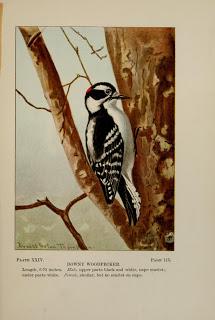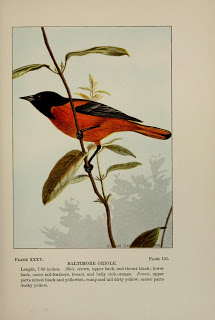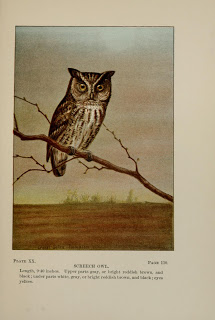Book of the Week: An Experiment in Illustrations
This week we’re going to do our book of the week a little differently. We came across this awesome tool on the National Geographic website called Backyard Bird Identifier. By answering some simple questions about a bird that you have seen in either the U.S. or Canada, the application tells you the possible species. We thought that was pretty cool, so we decided to see if this tool could identify birds based on answers that we give solely by looking at the illustrations and associated descriptions in one of the books in our collection. For our experiment, we chose the book Bird-Life: A Guide to the Study of Our Common Birds (1900), by Frank M. Chapman; illustrated by Ernest Seton Thompson. From this book, we chose six illustrations and, answering the questions in the Backyard Bird Identifier using these illustrations and accompanying descriptions, we found out whether the tool could accurately identify the bird. The six illustrations, as well as the answers we gave to the questions, are given below.

1) Downy Woodpecker (Dryobates pubescens medianus)
Question One: Where did you see the bird?
Answer: Country: United States
Region: Northeast, Virginia
Question Two: When did you see the bird?
Answer: October
Question Three: What color is the bird?
Answer: Black, White, Red
Question Four: How large is the bird?
Answer: 7-11 inches
Application returned 39 results (each possible match has an accompanying picture so that you can determine which of the results was your bird).
Results: Downy Woodpecker was among the possible identities.

2) Fox Sparrow (Passerella iliaca)
Question One: Where did you see the bird?
Answer: Country: Canada
Region: East, Quebec
Question Two: When did you see the bird?
Answer: May
Question Three: What color is the bird?
Answer: Brown, White, Red
Question Four: How large is the bird?
Answer: 7-11 inches
Application returned 42 results.
Results: Fox Sparrow was among the possible identities.

3) Baltimore Oriole (Icterus galbula)
Question One: Where did you see the bird?
Answer: Country: United States
Region: Northeast, Maryland
Question Two: When did you see the bird?
Answer: May
Question Three: What color is the bird?
Answer: Black, Yellow, Orange
Question Four: How large is the bird?
Answer: 7-11 inches
Application returned 38 results.
Results: Baltimore Oriole was among the possible identities.

4) Eastern Screech Owl (Megascops asio)
Question One: Where did you see the bird?
Answer: Country: United States
Region: Northeast, Virginia
Question Two: When did you see the bird?
Answer: August
Question Three: What color is the bird?
Answer: Black, Gray, Red, Brown, White, Yellow
Question Four: How large is the bird?
Answer: 7-11 inches
Application returned 44 results.
Results: Eastern Screech Owl was among the possible identities.

5) American Crossbill (Loxia curvirostra minor)
Question One: Where did you see the bird?
Answer: Country: United States
Region: Northeast, New York
Question Two: When did you see the bird?
Answer: January
Question Three: What color is the bird?
Answer: Black, Gray, Red, Brown
Question Four: How large is the bird?
Answer: 7-11 inches
Application returned 22 results.
Results: American Crossbill was not one of the possible identities.
6) Black and White Warbler (Mniotilta varia)
Question One: Where did you see the bird?
Answer: Country: United States
Region: South, North Carolina
Question Two: When did you see the bird?
Answer: April
Question Three: What color is the bird?
Answer: Black, White
Question Four: How large is the bird?
Answer: 6 inches or less
Application returned 32 results.
Results: Black and White Warbler was not among the possible identities.
So, at the end of the experiment, we were successfully able to bring up the identity of the bird in 4 out of 6 cases. Not too bad, considering we were working from a book and illustrations of the species. Try out the tool on your own, preferably from live bird studies :-), and let us know how successful your endeavors are. And be sure to take the time to look at the lovely illustrations in our book of the week. Maybe even try identifying other birds in the book using this tool. If you do, be sure to let us know how it goes! Happy bird identifying!
This week’s book of the week, Bird-Life: A Guide to the Study of Our Common Birds(1900), by Frank M. Chapman; illustrated by Ernest Seton Thompson, was contributed by the American Museum of Natural History.





Leave a Comment